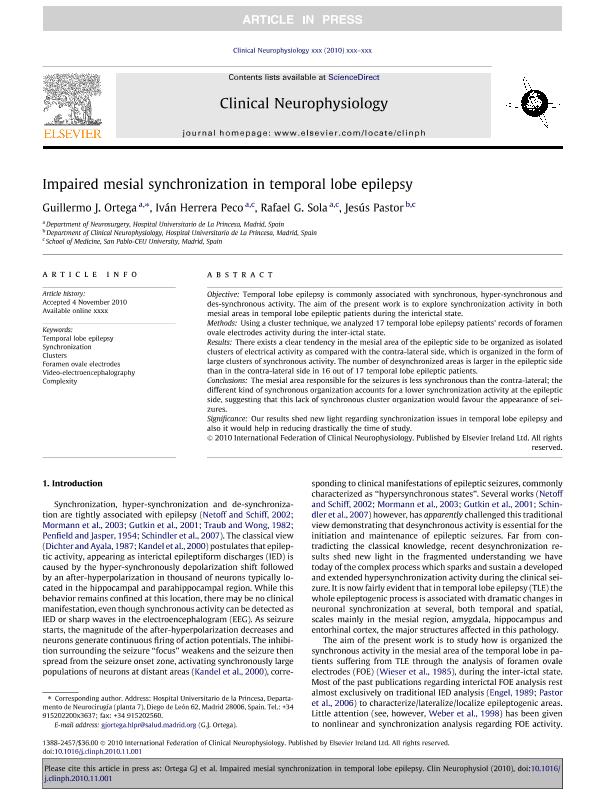Mostrar el registro sencillo del ítem
dc.contributor.author
Ortega, Guillermo José

dc.contributor.author
Peco, Iván Herrera
dc.contributor.author
Sola, Rafael G.
dc.contributor.author
Pastor, Jesús
dc.date.available
2023-04-20T11:06:59Z
dc.date.issued
2011-12
dc.identifier.citation
Ortega, Guillermo José; Peco, Iván Herrera; Sola, Rafael G.; Pastor, Jesús; Impaired mesial synchronization in temporal lobe epilepsy; Elsevier Ireland; Clinical Neurophysiology; 122; 6; 12-2011; 1106-1116
dc.identifier.issn
1388-2457
dc.identifier.uri
http://hdl.handle.net/11336/194671
dc.description.abstract
Objective: Temporal lobe epilepsy is commonly associated with synchronous, hyper-synchronous and des-synchronous activity. The aim of the present work is to explore synchronization activity in both mesial areas in temporal lobe epileptic patients during the interictal state. Methods: Using a cluster technique, we analyzed 17 temporal lobe epilepsy patients’ records of foramen ovale electrodes activity during the inter-ictal state. Results: There exists a clear tendency in the mesial area of the epileptic side to be organized as isolated clusters of electrical activity as compared with the contra-lateral side, which is organized in the form of large clusters of synchronous activity. The number of desynchronized areas is larger in the epileptic side than in the contra-lateral side in 16 out of 17 temporal lobe epileptic patients. Conclusions: The mesial area responsible for the seizures is less synchronous than the contra-lateral; the different kind of synchronous organization accounts for a lower synchronization activity at the epileptic side, suggesting that this lack of synchronous cluster organization would favour the appearance of seizures. Significance: Our results shed new light regarding synchronization issues in temporal lobe epilepsy and also it would help in reducing drastically the time of study.
dc.format
application/pdf
dc.language.iso
eng
dc.publisher
Elsevier Ireland

dc.rights
info:eu-repo/semantics/openAccess
dc.rights.uri
https://creativecommons.org/licenses/by-nc-sa/2.5/ar/
dc.subject
CLUSTERS
dc.subject
COMPLEXITY
dc.subject
FORAMEN OVALE ELECTRODES
dc.subject
SYNCHRONIZATION
dc.subject
TEMPORAL LOBE EPILEPSY
dc.subject
VIDEO-ELECTROENCEPHALOGRAPHY
dc.subject.classification
Otras Ciencias de la Salud

dc.subject.classification
Ciencias de la Salud

dc.subject.classification
CIENCIAS MÉDICAS Y DE LA SALUD

dc.title
Impaired mesial synchronization in temporal lobe epilepsy
dc.type
info:eu-repo/semantics/article
dc.type
info:ar-repo/semantics/artículo
dc.type
info:eu-repo/semantics/publishedVersion
dc.date.updated
2023-04-18T13:10:39Z
dc.journal.volume
122
dc.journal.number
6
dc.journal.pagination
1106-1116
dc.journal.pais
Países Bajos

dc.journal.ciudad
Amsterdam
dc.description.fil
Fil: Ortega, Guillermo José. Universidad Autonoma de Madrid. Hospital Universitario de la Princesa; España. Consejo Nacional de Investigaciones Científicas y Técnicas; Argentina
dc.description.fil
Fil: Peco, Iván Herrera. Universidad Autonoma de Madrid. Hospital Universitario de la Princesa; España
dc.description.fil
Fil: Sola, Rafael G.. Universidad Autonoma de Madrid. Hospital Universitario de la Princesa; España
dc.description.fil
Fil: Pastor, Jesús. Universidad Autonoma de Madrid. Hospital Universitario de la Princesa; España
dc.journal.title
Clinical Neurophysiology

dc.relation.alternativeid
info:eu-repo/semantics/altIdentifier/url/https://www.sciencedirect.com/science/article/abs/pii/S1388245710007856
dc.relation.alternativeid
info:eu-repo/semantics/altIdentifier/doi/http://dx.doi.org/10.1016/j.clinph.2010.11.001
Archivos asociados
